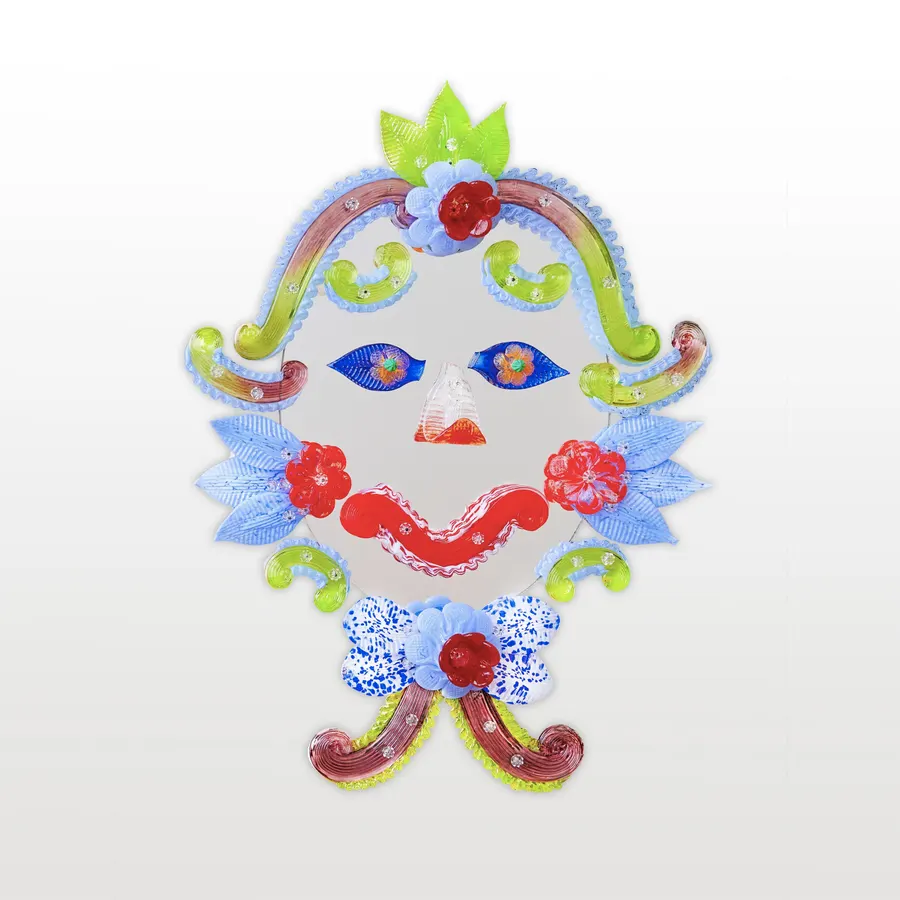Copyright forbes

“The Clown” Teste Composted wall mirror by Lucia Massari Courtesy Lucia Massari Oh, the irony. In an age of shrinking bodies and next-level vanity, today’s most coveted artist-designed mirrors don’t offer full body or even clear reflections. Instead, they incorporate surfaces and textures that fragment or obscure one’s image entirely. This is a trend that has been slowly building in the high-end design market, with pieces by artists who play with materials, shapes and layers to surprising, confounding and beautiful result. Framed: An Unjustifiable Collection of Shattered Self-reflection, opened earlier this month at New York’s Emma Scully gallery, a group exhibition in collaboration with Friedman Benda Gallery. The show (on view until December 13th), features new work from five artists and designers, who were encouraged to “shifts the focus from the mirror itself to its frame.” Four of the designs followed the brief, resulting in works that are at once alluring and functional . But one, by Dutch designer Marcel Wanders went rogue. Prism Collapse is described as “a gemstone in revolt, a diamond mid-shatter….its mirrored surface….fractured, scattered” that “invites viewers to confront their own reflection … as a shattered truth delicately held in place.” “Mirrors do to truth what bias does to knowledge,” says Marcel Wanders, designer of this mirror. Emma Scully gallery “It’s almost more fun when you can’t see yourself in it” mused Erica Boginsky, Director of Friedman Benda gallery and co-curator of the show. “Then what you are really looking at is the artistry of the work itself. It becomes more of a painting or a wall ornament than it does a vehicle for checking your make-up.” “Playing with reflection is a fine art concept that has been happening for a long time,” noted David Alhadeff, founder of The Future Perfect, a gallery with outposts in New York, Miami, Los Angeles and San Francisco. “Think of Jeff Koons’ Balloon Dog or Anish Kapoor’s Cloud Gate [aka: The Bean]. These are magically attractive things that seem to surpass trends and generations.” What follows is a selection of ten mirrors that speak to this trend. These designs challenge our expectations of what mirrors should look like and function, reimagining once-functional objects, that many took for granted, as sculptural works of art. Apertivo Collection by Bethann Laura Wood The “Olive” mirror from the Apertivo collection Daniele Iodice British designer Bethan Laura Wood collaborated with Venetian mirror specialists, Barbini, on this collection, which “ontinues her passion for fake food and the blurred line between the natural patterns and colours found in fruit and vegetables with the artifice of stylised food imagery and presentation.” Daniele Iodice The mirror’s creation was a comination of man and machine, with hand-formed details and modern cutting techniques that indulge the designer’s love of “the beauty of handmade swirls and curls” creating “marks like stylised droplets of juice or the pip of a exotic fruit.” Available through Nilufar. Verdigris Mirror by Teruko Kushi The Verdigris mirror is solid welded bronze, hand-polished and patinated along its perimeter, then sealed with automotive wax. Courtesy Otras Formas “What continually amazes me the most about working metals, especially bronze, is how complex and varied of a material it is,” notes Teruko Kushi, co-rounder of Salehi/Kushi and designer of the Verdigris mirror, above. “The fact that it can be polished, patinated, corroded, molten liquid and rock hard metaphorically feels akin to how we as people are often so much more complex, dimensional and varied in how we appear. I wanted to capture this spectrum of material transformation within the mirror, by incorporating the deep green-blue verdigris patina on the perimeter of the surface- a patina which naturally develops on bronze as its exposed to the environment over hundreds of years.” Available through Otras Formas. Sea Anemone 10 Wall Mirror by Pia-Maria Raeder Courtesy Todd Merrill Studio Each piece is hand made using thousands of individual beechwood rods Courtesy Todd Merrill Studio Pia-Maria Raeder left a career as a television journalist to apprentice with a furniture maker and ultimately create her own pieces. Her award winning Anemone series is hand-crafted using thousands of beechwood rods. “I thought that if I were to build furniture, I wanted to build something that worships the beauty of nature. This is my abstract interpretation of nature,” she explained. “[They also serve as] a reminder that it is worth taking care of nature, of our environment, and to think twice about what we do and how we do it. We should be thankful for what is left, and careful with our resources.” Available through Todd Merrill Studio. Lois Mirror by Darcy Miro Logan Jackson Logan Jackson Darcy Miro is an artist known primarily for metal work - at first jewelry but later, architectural pieces, most notably the facade of the American Folk Art Museum, now in the collection of the Museum of Modern Art. Six years ago, she visited a ceramics studio in Brooklyn and sunk her hands into clay. It was a moment she described as one of “unparalleled sensuality,” and it set her on a path of discovery and creation that resulted in a collection of objects for the home. This passion has not waned. Her mixed-media pieces are intricate, layered and slightly surrealistic designs that she hand builds herself. Many of her mirrors incorporate motifs reminiscent of girlhood — painted fingernails, braided hair, bows, and other playful references. Available through R & Company. OBJ-08 wall mirrors by Manuel Bañó Alejandro Ramirez-Orozco Manuel Bañó’s mirror designs look deceptively simple but a closer look reveals an intricate texture created from the repetitive motions of a human hand. The pair of wall mirrors in this series - one concave, one convex - are each made from a single piece of heated copper that craftsmen in Santa Clara del Cobre, Michoacán (Mexico) spend hours meticulously hammering onto a mold. After the desired shape is achieved, they then polish it by hand until it achieves a mirror finish. Alejandro Ramirez-Orozco Bañó, who co-founded Mexico City-based EWE Studio with renowned architect Héctor Esrawe and gallerist Age Salajõe, notes that the resulting sculptural piece is meant to, “occupy the space that would normally be taken by a painting on a wall.” Available through MASA Gallery. Mirror Palmea by Khaled El Mays Tarek Moukaddem Beirut-based deisgner Khaled El Mays Palmea mirror is part of a collection and solo show that debuted in 2021 at Nilufar gallery in Milan. Called “Jungle,” the collection was inspired by and explored the worlds of flora and fauna, and was produced in collaboration with local craftsmen in Lebanon. He says his “mirror-non-mirror,” made using wood, rattan and silk thread, was imagined as “an exercise of repetition of free forms that would emulate what could be the rain drops in a lake or pond... that whole idea of creating a ripple effect where the reflection is even more distorted,” adding “you can see somehow your reflection if you wanted to but it’s not fully there.” Available through Nilufar gallery. Narcissus mirror by Arthur Vallin Courtesy The Future Perfect “The Narcissus mirror was inspired by the Parliament in Flames by Turner,” notes Arthur Vallin, a French multi-disciplinary Creative Director based in New York City. “I’ve always thought it was an amazingly modern take on painting — especially when you place the piece back in the context of the 1800s.” Vallin purposely set out to create a mirror without a clean reflection; his brass creation is “burned” at the bottom by acids that are painted on with a brush, with a clearer “more pristine” texture on top. “There’s something slightly unsettling about seeing yourself not in a perfect reflection, but in one that’s subtly transformed — an imperfect echo of your own image.” Availble through The Future Perfect. Teste Composite by Lucia Massari Teste Composto - The Gentleman Francesco Allegretto Lucia Massari’s “Teste Composto” (Composite Heads) series of mirrors was inspired by Giuseppe Arcimboldo, a 16th century Italian painter known for portraits with faces that were an assemblage of fruits, vegetables, flowers and other objects. “Murano glass traditionally has been so serious. I thought, why not have fun with it,” noted the designer, who hails from and is currently based in Venice, Italy. “But I didn’t want it to just be funny. I wanted to show that glass can be experimental, critical and alive, not frozen in time or tradition.” Her enchanting creations feature typical elements of Venetian mirrors — swirls, rosettes, flowers and leaves — used to create eyes, noses, hair and even beards, thereby nodding to tradition while pushing the creative envelope. LuciaMassari.com Editorial StandardsReprints & Permissions



